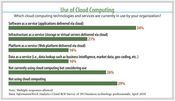4 Reasons Cloud Computing Isn't Overhyped
CIO of Schumacher Group, a midmarket physician management firm, says that as much as 85% of the company's processes are now cloud-based. Here’s why, and his advice on how to make the shift to cloud-based infrastructure.


12 Money Saving Tech Tips For SMBs
(click image for larger view)
Slideshow: 12 Money Saving Tech Tips For SMBs
The pitch for using hosted business applications rather than on-premises software is now familiar: Flexibility, cost savings, access, speed, and the list continues. But still, small and midsize businesses have to answer a simple question when it comes to software as a service (SaaS): Why?
In other words, if it doesn't produce tangible benefits or solve particular business problems: Why bother?
For Schumacher Group, a physician management firm with 900-plus employees and counting, SaaS is both problem-solver and innovation-enabler rather than just an overhyped trend. CIO Doug Menefee said that as much as 85% of the company's processes are now cloud-based.
The company's SaaS surge started with Salesforce.com for customer relationship management. They've since added Google Apps for the 3,000 doctors that Schumacher contracts with, Workday for human resources information systems, and several niche products such as Host Analytics for finance tools. On the infrastructure side of the things, Menefee said he's also beginning to rely more heavily on Amazon's EC2 cloud and Google's App Engine. (For clarity: I'll use SaaS and cloud interchangeably here as umbrella terms for IT functions hosted off-site.)
To be sure, Schumacher Group isn't all-in on cloud. Menefee still runs two multi-million-dollar data centers and around 200 on-premises servers. But the company is coming close: When addressing new business requirements, Menefee said that decision-making and delivery has shifted to between 90% to 95% in favor of off-site.
"As an IT organization, we listen to what the business problem is and then we'll bring on-premises as well as cloud-based solutions to the table," Menefee said in an interview. "Nine times out of 10--and that's probably closer to 9.5 times out of 10--the cloud products are winning today."
Back to the simple question: Why? Those answers might look a bit different for every business; here are Schumacher Group's.
The first reason is geography: Schumacher Group has branch offices around the country, but it's headquartered in Lafayette, La.,--roughly halfway between where Hurricanes Katrina and Rita each made landfall in 2005. "Being a new CIO for the organization, I recognized the susceptibility of our data center," Menefee said.
The second reason: Faster deployment speeds. Menefee attributed the overwhelming lean toward cloud-based technologies to his team's ability to get them up and running much quicker than it would otherwise be able to with on-site options. His department numbers around 50 people, with 10 focused on Web services.
The third reason very much relates to the second: Schumacher Group has been growing rapidly, adding 350 employees since Menefee took the CIO post around six years ago. "With us being a fast-growing company, I wouldn't be able to put in the server infrastructure and the capital investments up front that would scale as quickly as the organization," Menefee said.
The fourth reason follows suit: Frequency of updates and enhancements. Menefee likes getting new features and functionality on a regular basis without strangling his internal resources to do so--not always the case when upgrading on-premises deployments. "It may take me six months to update a SharePoint environment, and that's on my schedule," he said.

Analytics Slideshow Calculating Cloud ROI
Analytics Slideshow Calculating Cloud ROI(click image forlarger view and for full slideshow)
One of the biggest benefits in Schumacher Group's heavy cloud investment has been how Menefee is able to prioritize IT resources as result: Most of his department is focused on areas such as business analysis, project management, development, and innovation rather than infrastructure and services support.
"I can spend 60% to 80% of the budget dollars on bringing net-new for the organization as opposed to just supporting infrastructure," Menefee said.
Cost savings is another benefit, though it's not as straightforward as some vendors might like you believe. Menefee said that in his experience, making a total cost of ownership (TCO) case for SaaS versus an on-site deployment depends on the timeframe.
"A three-year TCO on software as a service, the on-premises solution would win nine times out of 10," Menefee said. "If I pushed that to a five-year TCO, the software as a service would win." Menefee attributes that to the hardware and software upgrades--and the possibility of needing to bring in professional services support--necessary in a typical release cycle for on-premises deployments.
Menefee has some lessons learned for fellow IT executives and managers pursuing a similar shift to cloud-based infrastructure, applications, and services. Here's his advice:
-- Focus on application integration from the start, and make single sign-on a priority. It's unlikely that you'll find a one-size-fits-all vendor that meets each of your needs, and Menefee said IT managers and administors will have security issues and other headaches if their end users have to manage multiple logins and accounts. Consider middleware applications; Schumacher Group uses Boomi and Cast Iron for integration, and Symplified for single sign-on. Plan for future needs rather than just the current landscape. "Not waiting until you get four or five applications into it is always a best practice," Menefee said.
-- Assign in-house project management, and don't buy the hype that cloud means you don't need IT involved. "We found that when we didn't have internal project management resources and left it up to [the vendor] to work with our end users, the project didn't move as effectively and efficiently as it could have," Menefee said.
-- Take service-level agreements seriously, and be realistic with them on matters such as security. "Be honest with yourself when you look in the mirror," Menefee said. "What security practices do you have in place versus what they have in place?"
As Schumacher Group approaches the 1,000-employee mark and beyond, Menefee said it's unlikely the company will ever be 100% cloud-based. But he thinks that smaller businesses and new startups should seriously consider the idea.
"If I were a small business today in a startup mode, I would have very few--if any--on-premises solutions because of how mature the marketplace is today versus what it looked like five or six years ago," Menefee said.
Small and midsize businesses are falling prey to cyberattacks that cost them sensitive data, productivity, and corporate accounts cleaned out by sophisticated banking Trojans. In this report, we explain what makes these threats so menacing, and share best practices to defend against them. Download it now. (Free registration required.)
About the Author
You May Also Like






